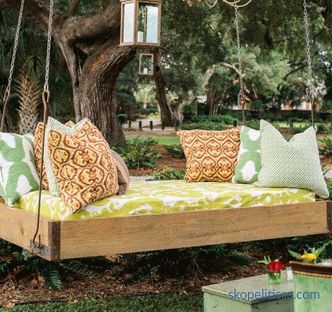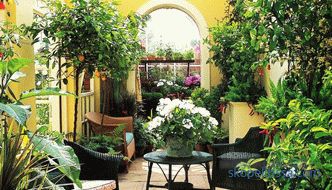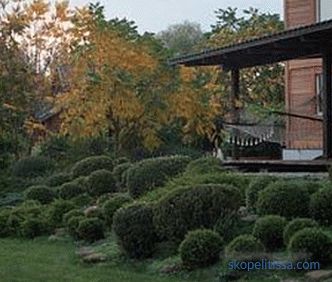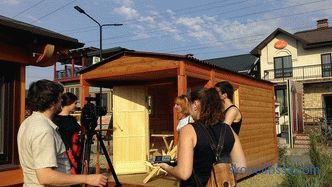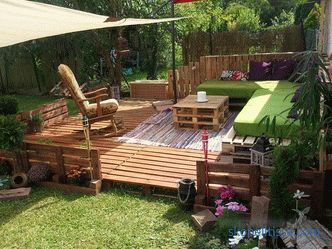One of the priority directions of development of modern civil engineering is the use of new building materials, which qualitatively improve the energy and heat-saving properties of residential buildings. Heat-efficient wall materials, commonly referred to as heat blocks, can provide a comfortable temperature inside the house in the most adverse weather outside the building. The construction of houses from heatblocks attracts developers and construction companies due to the variety of architectural solutions and high speed of erection of structures.
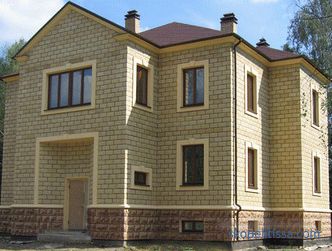
What is a heat-efficient block?
A distinctive feature of a heatblock , compared with traditional stone wall materials, is its low thermal conductivity, providing the necessary thermal protection of residential premises with a minimum wall thickness.
If we compare wall materials by the magnitude of reduced resistance to heat transfer R0, determined in accordance with SP 50. 13330. 2012 "Thermal protection of buildings. Updated version SNiP 23-02-2003", then by its heat-shielding characteristics, the wall is from blocks with a thickness of 30 cm are not inferior to a brick wall with a thickness of 230 cm and a concrete wall - 450 cm.
Such high thermal efficiency of the blocks is provided by a carefully designed unique design, which is a combined three-layer system (like a sandwich) made of ceramic itobetona and polystyrene.
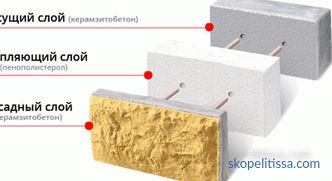
Projects of houses from heatblocks fully meet the basic concept of industrial construction: “Everything is in one”, because each the heatblock layer performs a specific function:
- the carrier function according to the perception of the weight load of the building is performed by the inner layer of claydite concrete;
- a layer of polystyrene, placed between the inner and outer layers of the block;
- enclosing and decorative functions is performed by the outer layer oh, also called facial or textured, imitating brick or natural stone trim.
Structurally similar three-layer structure of the heat block is implemented as follows:
- Support layer made of porous claydite-concrete (a material based on cement mortar, clay and special additives). The thickness of the carrier layer - within 120 mm.
- The middle layer , called the thermal insert, is made of expanded polystyrene. The thickness of the thermal insert is from 120 to 200 m.
- The textured layer is also made of expanded clay concrete. Layer thickness - in the range of 50-80 mm.
In order to prevent possible exfoliation of the wall material due to the physical heterogeneity of expanded polystyrene and expanded clay concrete, all layers of the heat block are fastened together with reinforcing bars made of basalt or fiberglass.
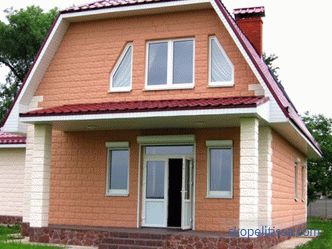
How are heatblocks produced?
For the manufacture of three-layer heat-efficient wall blocks special matrices are used , providing fixation in a uniform design of all three functional layers of the product. The block is formed in the matrix in the following sequence:
- a polystyrene liner is installed in the matrix;
- the claydite-concrete mixture prepared in the mixer is poured;
- the mixture is sealed using special equipment .
For the layer-by-layer connection and fixation of internal elements, the polystyrene foam liner is equipped with special fasteners (plastic anchors or reinforcing bars).
Many manufacturers prefer to engage the dovetail thorn groove (the spikes and their corresponding grooves are in the form of a trapezoid) to a pin-point connection, which provides a more reliable monolithic system assembly.
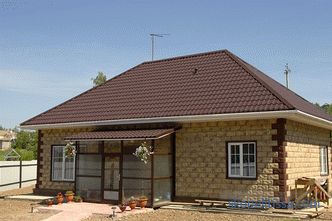
What are heat-efficient blocks?
The range of heat-efficient wall materials is quite wide. In the projects of houses from heatblocks (a photo of one of the projects is given below), the builders organically combine the multifunctionality of wall blocks with the possibility of erecting buildings in any architectural style without additional lining.
Heatblocks are classified according to the following main features:
- By size - the dimensions of the length, width and height of the block, depending on the purpose, vary in the range of 200-500 mm, for example, it can have a heat block 500x300x200 mm, 400x300x200 mm or 200x300x200 mm.
- By purpose - the blocks can be inline, corner, end or other configuration.
- about the structure of the base layer - monolithic and hollow.
Also, heat-efficient blocks have different strength indices depending on the brand of claydite used and differ in the material of the heat insulating layer.
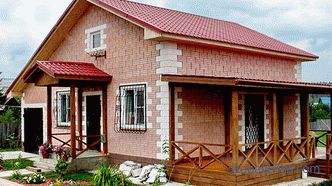
Advantages and disadvantages of building structures from heatblocks
When discussing the advantages and disadvantages of houses from heatblocks, the owners' reviews accentuated the following positive factors :
- excellent heat insulating and energy saving properties of the heatblocks, providing comfortable living conditions;
- excellent sound absorption and reliable sound insulation;
- long trouble-free service life of the wall block;
- environmental cleanliness of the materials of each of the heatblock layers;
- materials in the block susceptible to rotting and microorganism exposure;
- a high degree of fire safety, since polystyrene of the middle layer
- is treated with special impregnations that are resistant to fire.
Heating costs for residential premises in winter time for a house from heatblocks is 3-3.5 times lower compared to a brick house of a similar layout.
Additional advantages of heat-efficient block materials are the advantages that distinguish the technology of building a house from heatblocks from building a stone house according to traditional technologies:
- minimum effort for single-row masonry wall material;
- no exterior finishing;
- the use of adhesive for masonry saves a large amount of water, cement and sand required for kneading mortar;
- using simple lifting equipment instead of expensive heavy construction machinery.
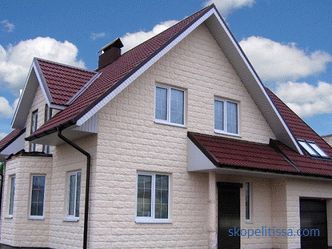
Of the drawbacks, the heatblock differs in the following moments :
- a relatively large weight of the wall block (within 25 kg) creates difficulties in laying;
- the likelihood of heat loss with poor-quality sealing of joints between adjacent blocks;
- a wide range of wall block products required for accurate assembly of the walls of the house, complicates the calculation of the optimal number of blocks for each position of the house project;
- low vapor permeability of the heatblocks is able to create pa The living effect in the living room, as a result, the house requires the installation of a high-quality ventilation system.
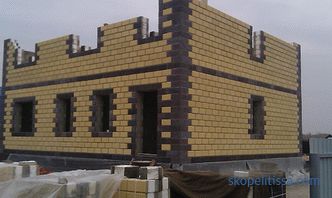
Features of building a house from heat blocks
Building a residential house from wall heat-efficient blocks are carried out according to the following algorithm:
- a foundation is constructed taking into account the nature of the soil and the groundwater level indicator;
- the wall structure of the building
- is being erected; 35>
- roofing is laid.
Each stage of construction with the use of blocks has its own characteristics that distinguish it from the technology of building houses from traditional materials - brick, concrete or wood.
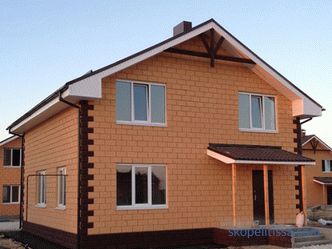
- When choosing the type of foundation , a small amount of weight is taken into account loads of the erected building, since the walls are represented by single-layer masonry In that case, if the soil on the site allows building shallow-deeper foundations (the base recessed into the ground by 30-70 cm), then for a house from heat-efficient blocks a strip foundation with a small depth is sufficient.
- When building a wall the blocks are laid on a special glue with a thickness of 2 to 5 mm, while the glue is not applied to the expanded polystyrene.
- When installing the roof of a house from heat blocks , the roof system can be either wooden or metal. Roofing materials are allowed any, most often the choice depends on the personal preferences of the customer.
The strip foundation is a foundation in the form of a single concrete strip running along the perimeter of the building and under its supporting walls.
In the Russian market of building materials, heatblocks are offered in the form that does not require additional painting or finishing. Changing the texture or color of the heat block is performed at the request of the home owner using brushes, rollers or spray guns. The most popular finish inside the walls of the house. In such cases, a reinforcing mesh is used to prevent peeling of the stucco applied to the wall.
The cost of building houses from heatblocks
Organizations engaged in the design and construction of houses from turnkey heatblocks determine the price of their services depending on the number of floors of a residential building and the amount of work. In the catalogs, construction companies usually give two prices - a set of wall products separately and the total cost of building a house.For example, the cost of a set of heatblocks for a one-story house with a total area of 86 m 2 is almost 300 thousand rubles, while the construction of such a house on a turnkey basis is estimated at 1,550 thousand rubles. For a preliminary assessment of the value of the house for which thermoblocks are applied, the price per 1 m2 of the building area varies from 15 to 20 thousand rubles.
The intensive nature of modern construction opens up a broad perspective for technologies with wall heat-efficient units, since recently when ordering the construction of a country house more attention is paid to the timing of the order and issues effective energy saving. In such cases, the use of heatblocks will be more preferable in comparison with traditional building materials.
On our website you can familiarize yourself with the most popular projects stone houses from construction companies represented at the exhibition of Low-Rise Country houses.
Rate this article, we tried for you
